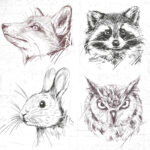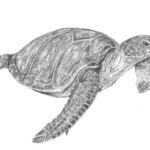How to Draw a Dog Face with Pleasingly Realistic Features
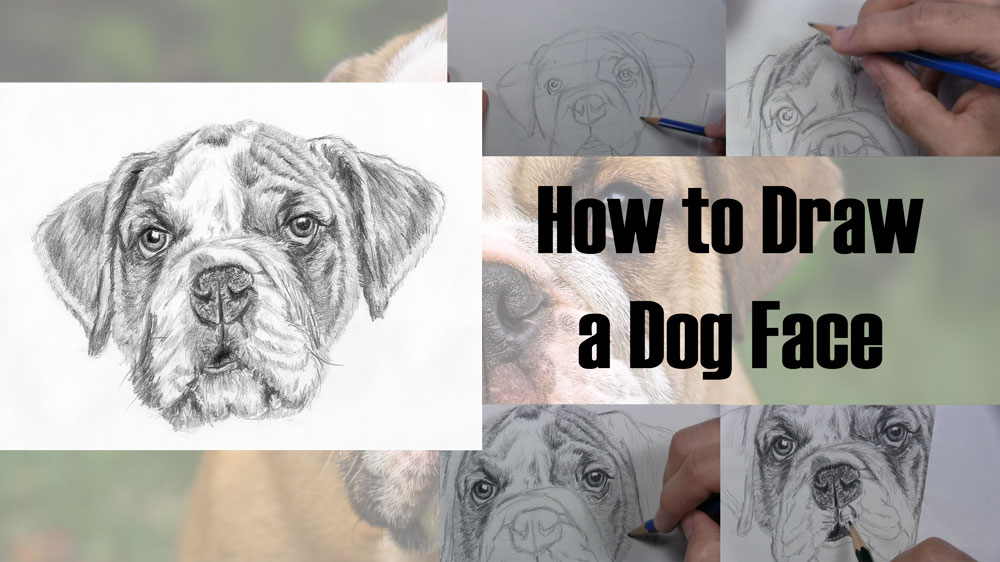
Would you like to know how to draw a dog face?
When searching for ideas of what to draw, people often look no further than their pets for inspiration. It’s only natural for dog owners to want to draw a portrait of their favorite four-legged companion.
Perhaps you have a dog of your own that you would just love to draw.
Or, maybe you don’t own a dog but you just think they are cool. Maybe you see so much personality in the face of a dog that you just have to draw it, or at least try.
But what if you don’t know how?
In this tutorial, I will show you a step-by-step method for drawing the face of a dog. This tutorial will be basic enough for you to keep up with as a beginner but detailed enough for you to still end up with a pleasing realistic drawing of a dog face.
Table of Contents
Use a Reference Photo of a Dog Face
Here’s a picture of the little guy we are going to draw. As you can see, this tutorial will show you how to draw the face of a bulldog, an English bulldog to be precise! We will use this as our reference photo and to help us with proper placement of all the dog’s facial features.
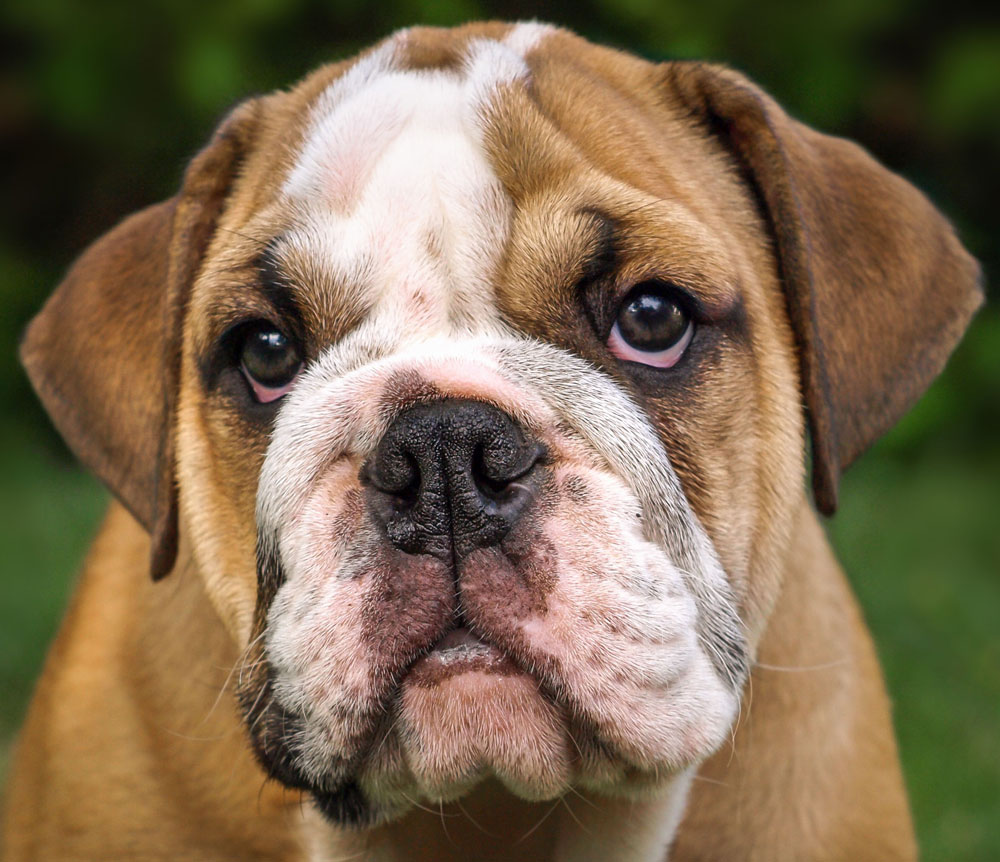
You can use the basic concepts you learn from this tutorial and apply them to drawing other dogs. Since there are so many different breeds of dogs with such a variety of physical traits, using a reference photo is an important step in capturing accurate features of any dog face you choose to draw.
Materials Used for This Drawing
Here is a list of the materials I am using for this drawing.
If you don’t have some of these materials, don’t let that stop you. A sheet of paper, a standard pencil, and an eraser are a great start!
If you wish to purchase any of these materials, they can be found at your local art store, or you can buy them using the links below.
Affiliate Disclaimer: The links below are affiliate links. I will receive a small commission if a purchase is made through one of these links. Learn more here.
- Sheet of drawing paper
- Sheet of folded paper to prevent smudging
- HB, 2B, and 6B graphite pencils
- Kneaded eraser
How to Draw a Dog Face Video Tutorial
You can watch the time-lapse video version of this tutorial below. Watch it once all the way through to get a sense of the overall process. Then watch a second time and draw along with me, pausing as needed.
As an alternative, when you sign up for the Let’s Draw Today Newsletter, I will give you the extended video course version of this tutorial and 9 others (10 in all) as a free gift!
Free Bonus: Click here to get access to 10 free drawing video tutorial courses. Draw along with me in the full-length version of this tutorial and 9 others as I show you one step at a time my entire process for drawing each subject from start to finish.
Draw Guidelines for the Dog’s Facial Features
Let’s first see how to draw the head of a dog. Start with an HB pencil and a rough sketch of a circle for the dog’s head. Next, sketch a vertical line and a horizontal line for some facial guidelines. There should be an ever so slight curve to each of these lines due to the tilt of the dog’s head.
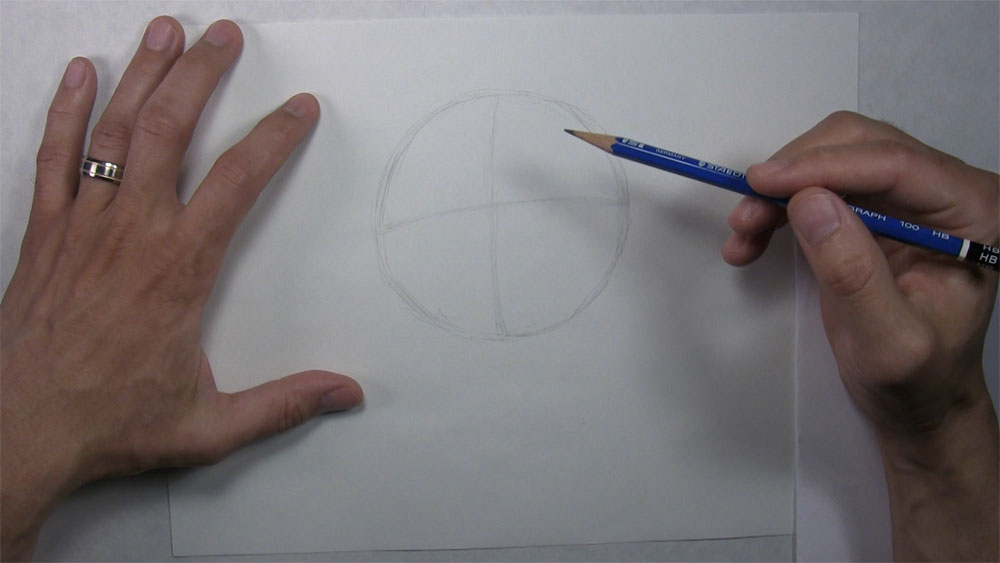
Plan the placement of the eyes. They should be approximately an equal distance from the center. Then, sketch the shape of the snout. Extend the snout below the circle and make the bottom parallel to the horizontal guideline on the circle.
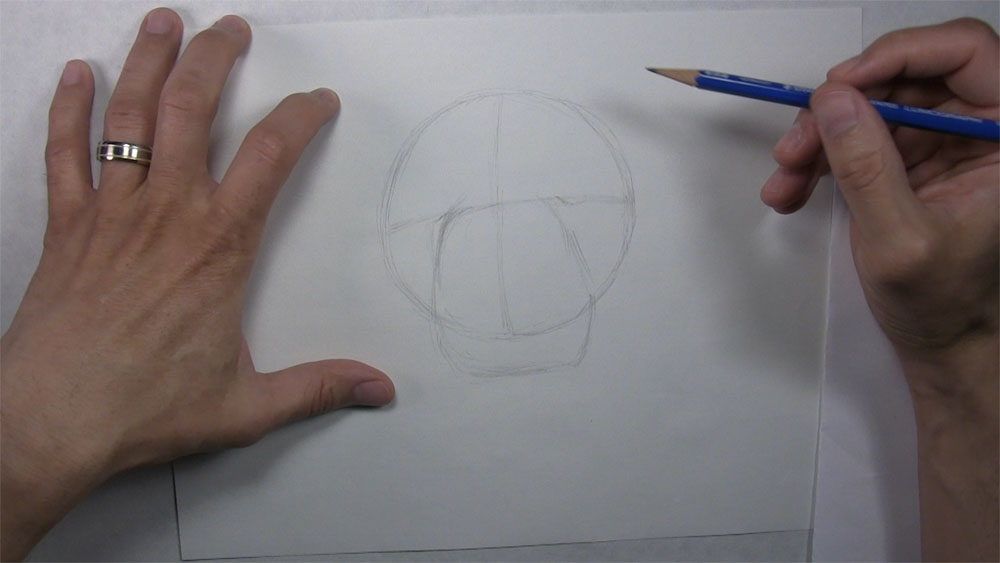
Now let’s work on developing the shape of the dog’s eyes. Although this dog has some large eyes and very round eyeballs, the shape of the skin surrounding the eyes is very angular. They almost resemble pentagons, but they still have some curvature.

Start sketching the brow on the side of the face next to the dog’s right eye. That’ll be on our left side. Then sketch the outline of the nose. Pay attention to placement in relation to the surrounding features. For example, the left edge of the nose is a little to the right of the dog’s right eye. Similarly, there is more space between the dog’s nose and his left eye due to the turn of his head.
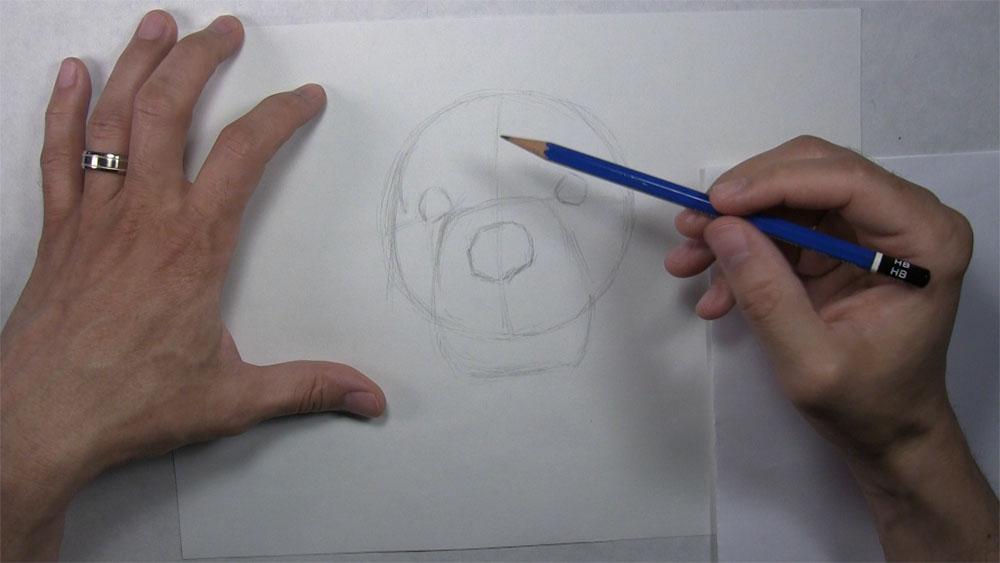
Draw the Dog’s Ears and Nose
The bottom tip of the ear should align with the bottom of the nose. Also, the pointy side of the ear that sticks out is aligned with the upper portion of the eye. Draw a curved line from the bottom tip. Sketch the outline for the brow. Draw the upper edge of the ear from the outer tip to the brow. A little higher, draw a flap connecting the ear to the head.
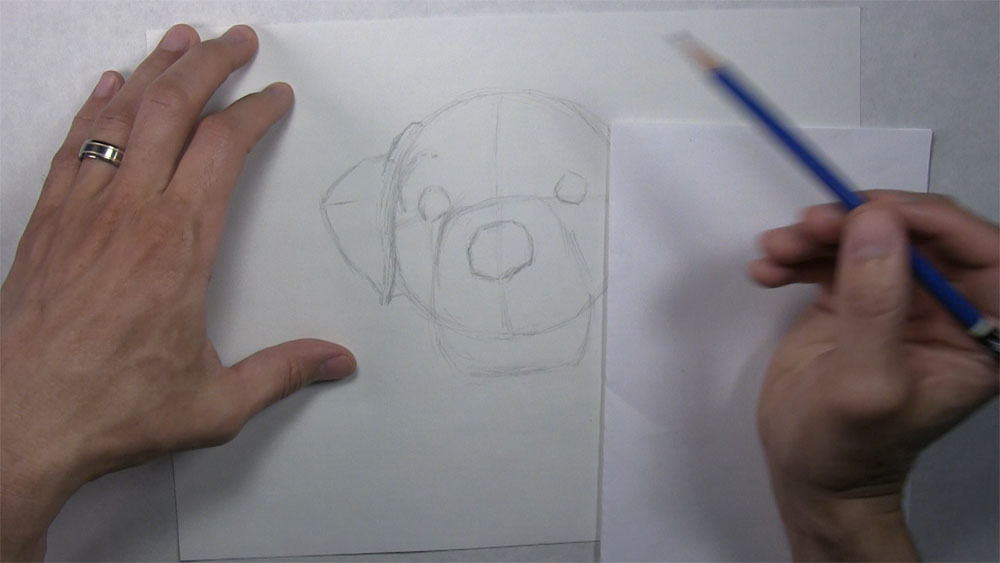
Sketch a guideline from the first ear to locate the connection for the other ear. Then, sketch the brow of the dog’s left eye. Draw the side curvature of the dog’s face and the edge of the ear along the side. The lower tip of the ear is slightly aligned with the first ear and the nose. Use the outer tip of the first ear and the top of the dog’s left eye to locate the outer tip of this ear. Use a pencil to check the angle. Connect the ear at the head. This preliminary sketch of the dog ears is the first step in learning how to draw them.
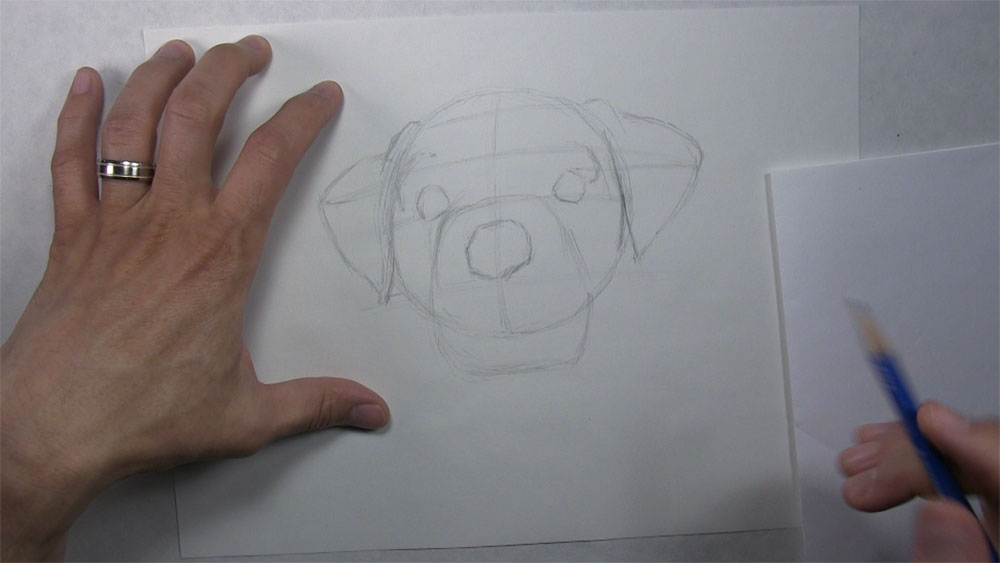
Draw a vertical line separating the nose into two parts. Then, sketch the nostril on our right side. Pay attention to the size of the nostril as well as the shape. Repeat this process with the other nostril. Try to match the angles of the outline of the nostrils correctly in relation to the angles of the nose outline.

Draw the Dog’s Mouth
Since the face of this dog we are drawing is the face of a bulldog, there are a lot of wrinkles or flaps, especially around the nose and mouth. Start by sketching some wrinkles extending from the nostrils and a short line below the nose.
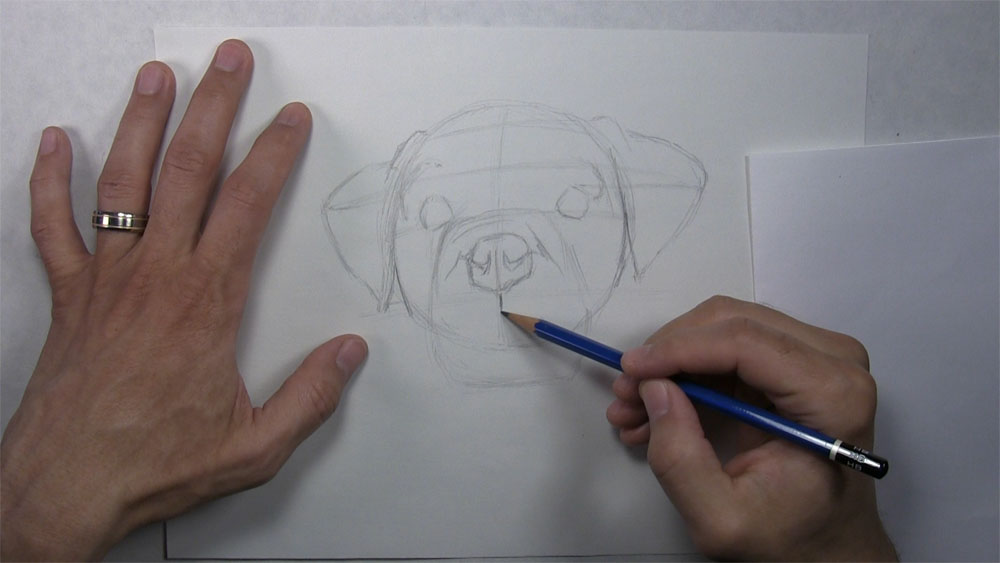
Now, let’s see how we can draw the mouth of the dog in a way true to the reference. Start branching out the mouth from the short line below the nose. Keep branching out until you are aligned with the inner corner of the eye. Then start curving the bottom of the snout. Repeat this on the other side. Check the slope of the line connecting both sides of the bottom to make sure it is the same angle as the horizontal guideline of our original circle.
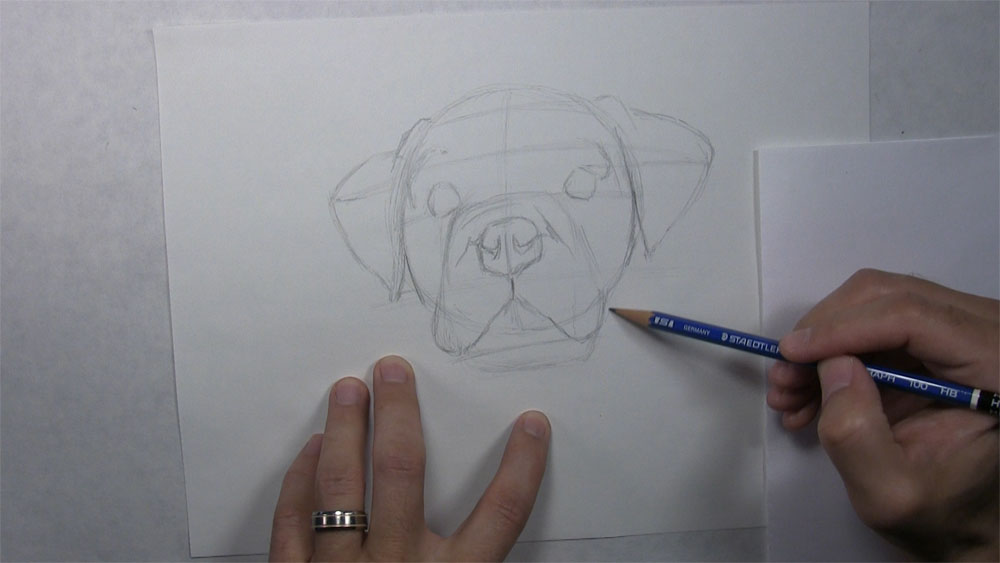
Draw a slightly curved line to show the opening of the dog’s mouth. Repeat this for the bottom of the lip. Although we don’t have to with this drawing, there will be occasions when drawing a dog’s mouth requires you to draw its sharp teeth. Draw what looks like a “W” shape under the mouth. Leave a little space between this and the bottom lip. Draw the lower area of the snout with some wrinkles along the lower edge.
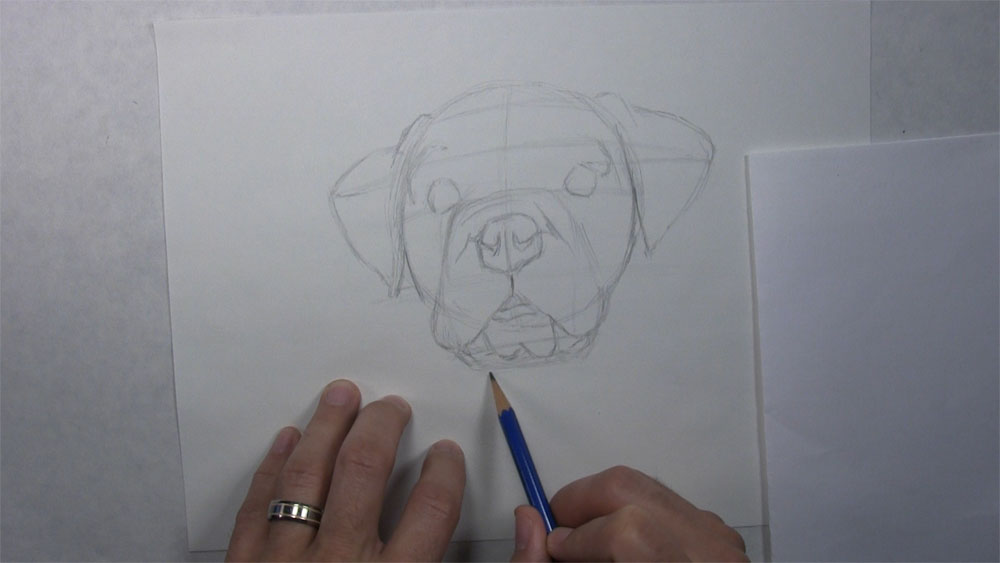
Draw the Dog’s Eyes and Side of the Face
Here’s how to draw dog eyes step by step. Starting with the eye to our left, I’m sketching a line on the underside of the brow to allow for how much it protrudes. Then, we can draw a squarish highlight. For this iris and pupil, try to draw them as circular as possible. For the other eye, I’m drawing the iris and pupil first. I’m saving the highlight for last. The order doesn’t really matter. Just make sure you leave a little opening for the highlight.
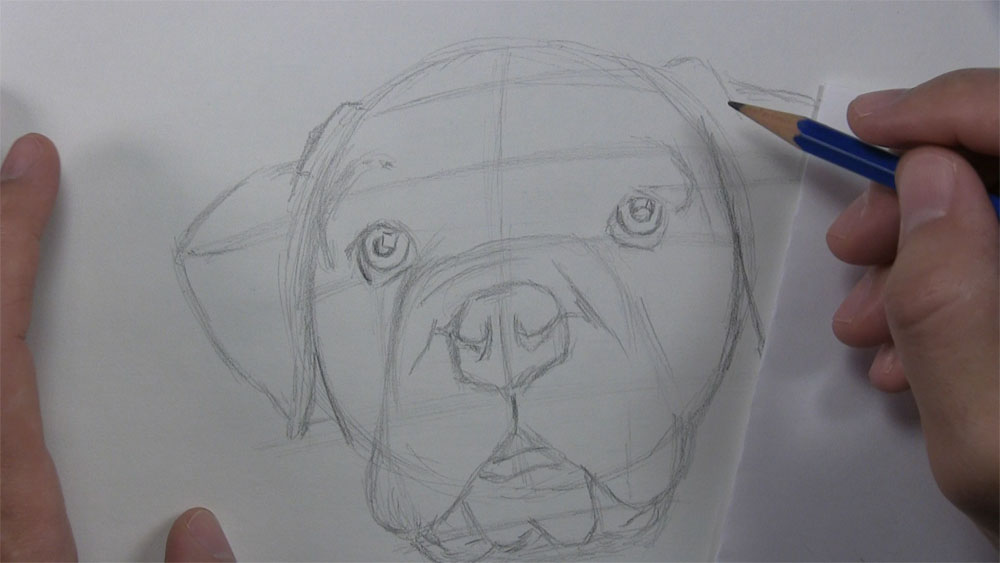
From the edge of the iris, we can see a little wrinkle on the brow. As we keep looking at this brow, we can notice even more wrinkles. There are some pretty deep and significant ones at that. Keep drawing lines to develop the shape and wrinkles of the brow.
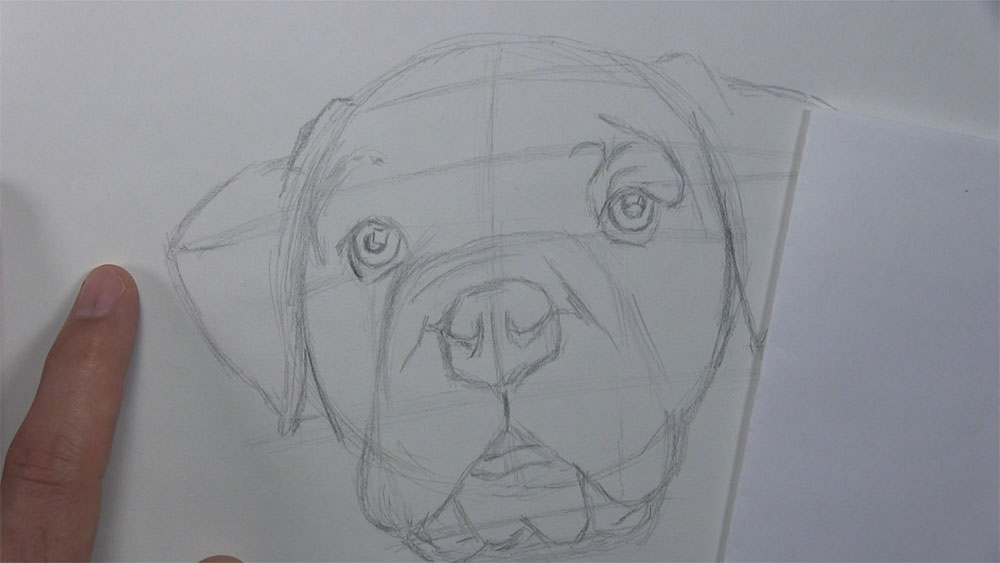
Sketch a thin line just under the eye to represent the eyelid. Also, there is a long fold or wrinkle on the side of the face running along the brow. Develop the top portion of the brow a bit more. Draw a line running along the white patch of fur going down the dog’s forehead. Curve this line downward to shape the side of the snout. Then sketch a few more wrinkles under the eye and on the cheek.
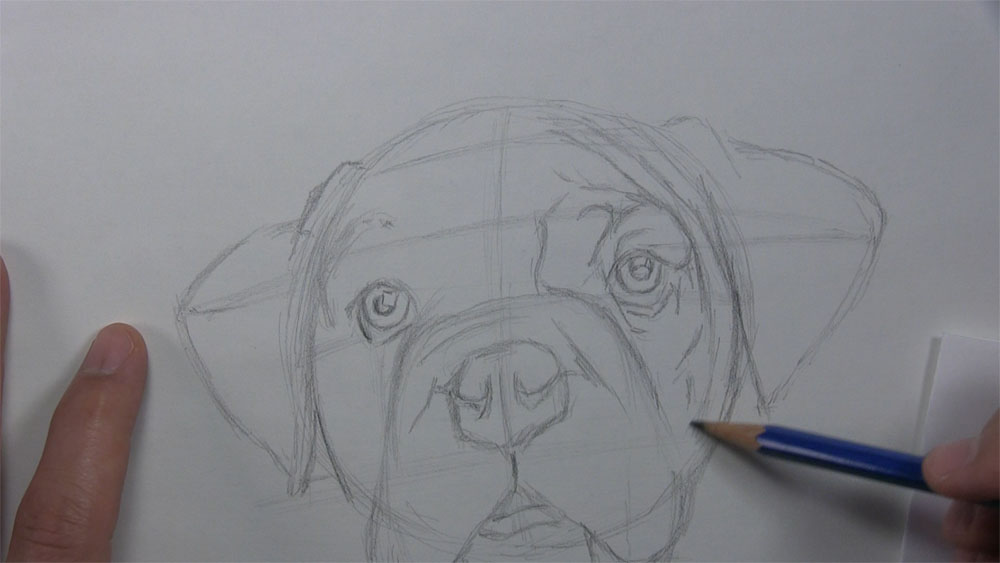
Draw the Rest of the Upper Face
First, draw a tip to the bottom of the brow to the left of the dog’s right eye. Then, draw a dip in the brow similar to what the other brow had. There’s also a long wrinkle along this side of the face. Now, I’m defining the outline of the snout. Since the head is slightly turned, make sure the snout overlaps the corner of this eye just a little. Sketch a few lines to develop the area above the brow.
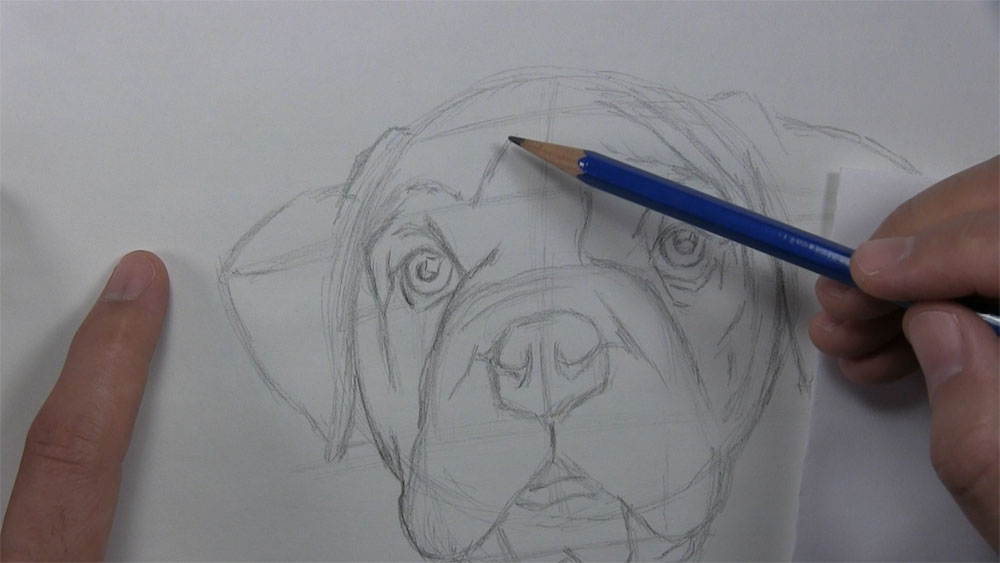
Draw a line for the side of the face that hides behind the dog’s protruding brow. Draw the bumpy contour that is the top of the dog’s head. Afterwards, start drawing some of the forehead wrinkles and the edge of the white fur pattern. There are several overlapping layers of thick, flappy skin, so it’s helpful to use the reference photo as a guide.
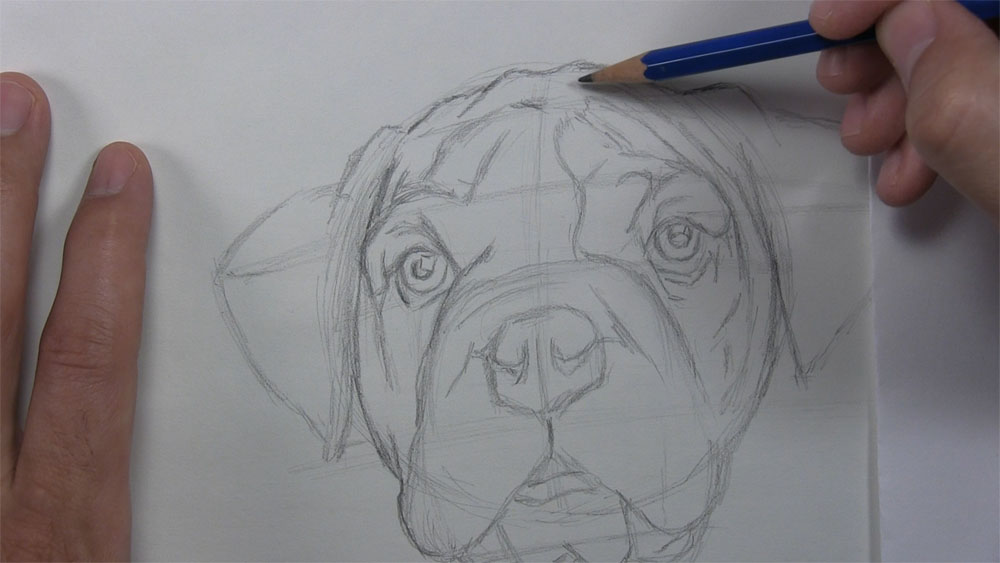
Since we have our facial features in place, we no longer have a need for our guidelines. Use a kneaded, plastic, or regular eraser to get rid of them. The kneaded eraser is best for maneuvering around those very tight areas.
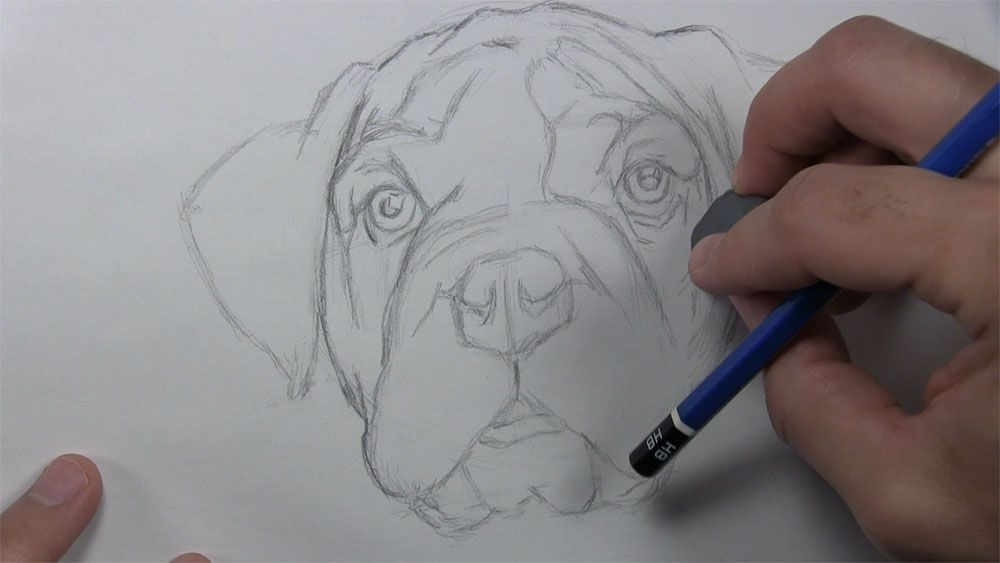
The design pattern on this dog or any other animal must follow the bends and folds of the surface upon which it lies. Draw the outline of the white fur pattern. Make sure to curve the outline up and around the wrinkles. Draw the frown lines, or forehead furrows, between the eyes, just above the dog’s left nostril.
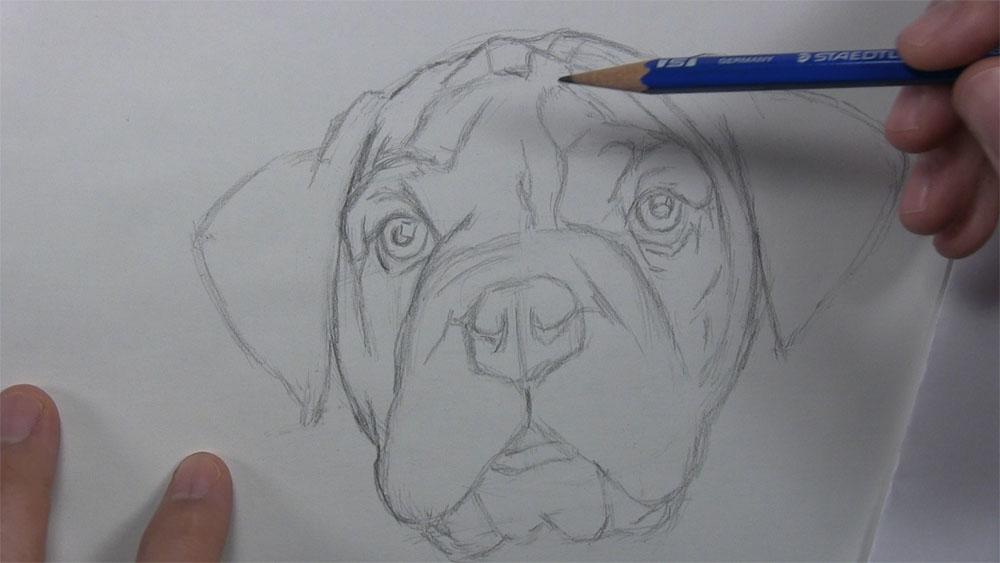
Finish Outlining the Snout and Ears
Now, let’s work on the snout. We have some thick overlapping folds here above the nose. Sketch a line coming down beside the nose. Sketch a shorter, somewhat horizontal line immediately to the right of the nose. Keep working your way down.
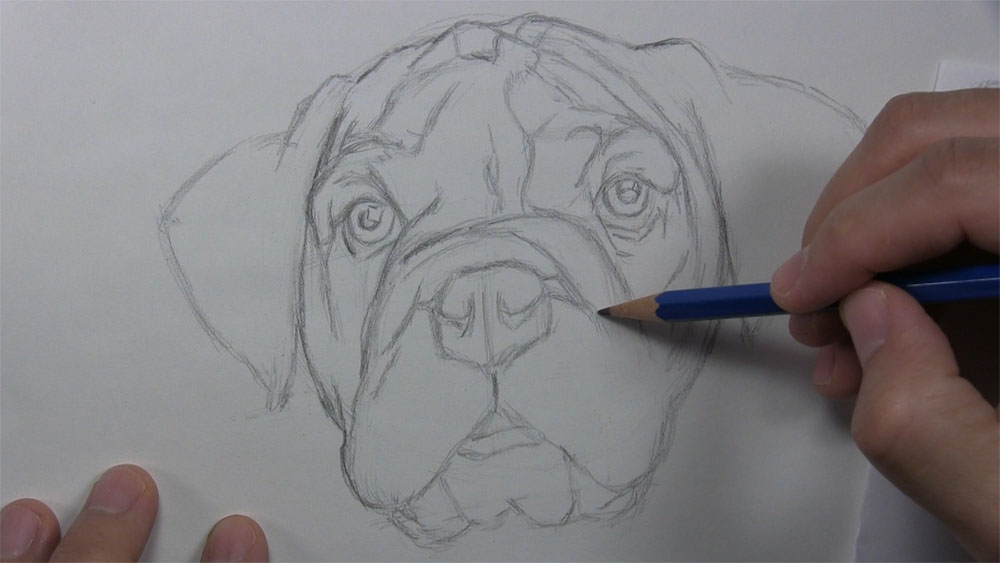
Draw a bumpy line going down each side of the snout. These lines represent the outer edges of the rows of wrinkles between the nose and the mouth from where some of the whiskers originate.

From these two outlines, just begin sketching very light lines indicating the folds. These light lines should travel upward toward the nose. Also, there is a bit of curvature on some of the lines.

Sketch an indication of tonal value changes on the ears. These light lines will be helpful during the shading process. They will let us know where we need to shade lightly and where we need to shade a bit darker.
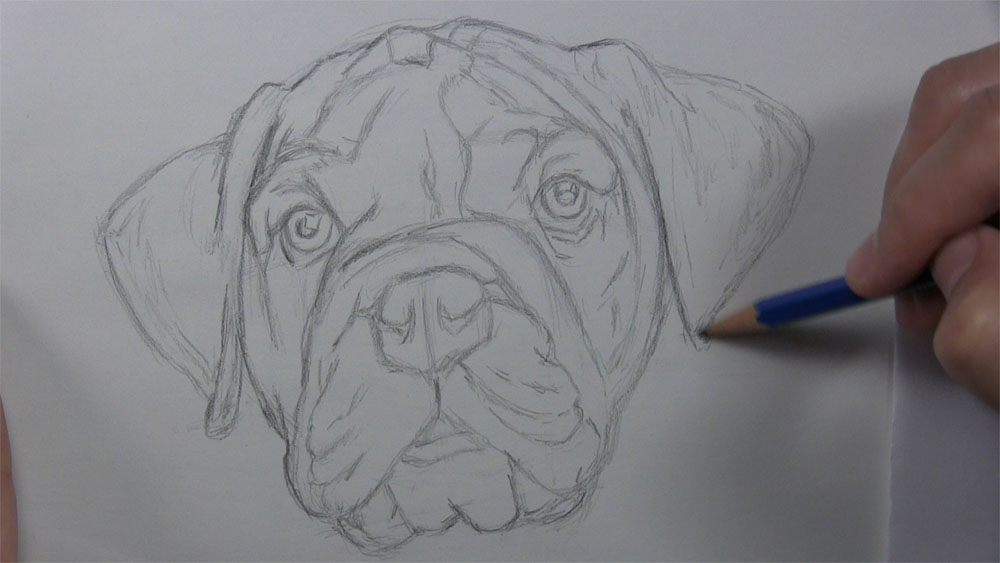
That just about does it for how to draw the outline of a dog face.
Of course, if you draw a dog face but neglect to shade it, some people might consider something to be missing. Therefore, we’ll look at the shading steps next.
Shade the Forehead
Starting with the top of the dog’s head, I’m sticking with my HB pencil as I add a light base layer of fur. We will gradually build up the fur with darker layers of value. For a more jagged, furry edge to show where the outlines are, make sure to erase the outline before drawing the fur. Keep your pencil strokes nice and short. By the way, the steps I show you for how to draw dog fur are the same basic steps for drawing all animal fur.
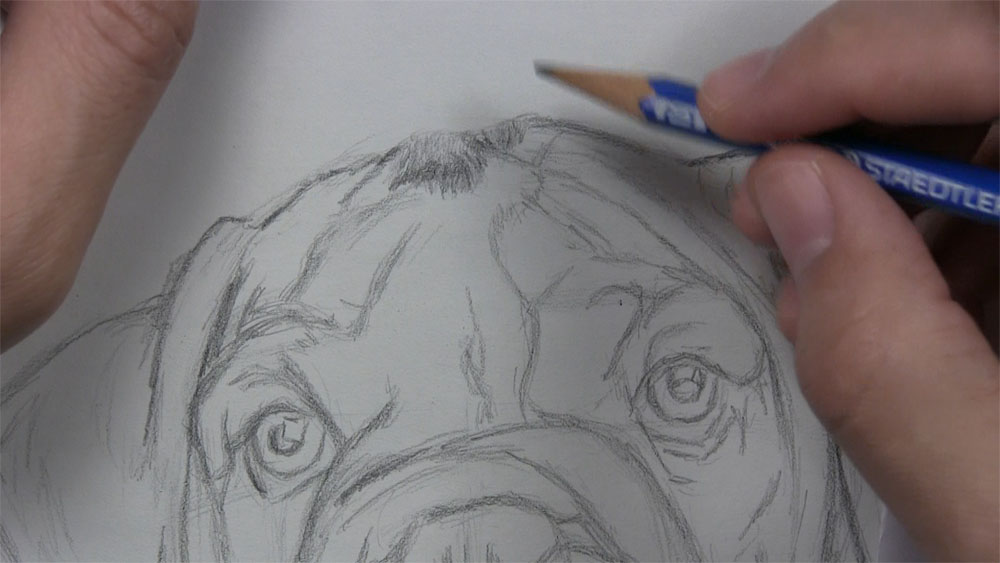
Keep drawing more fur for the top of the dog’s head. Use the same method. Make sure you don’t put too much shading in the white fur on the forehead. Remember to add shading between the wrinkles too. Always draw fur in the direction of hair growth.
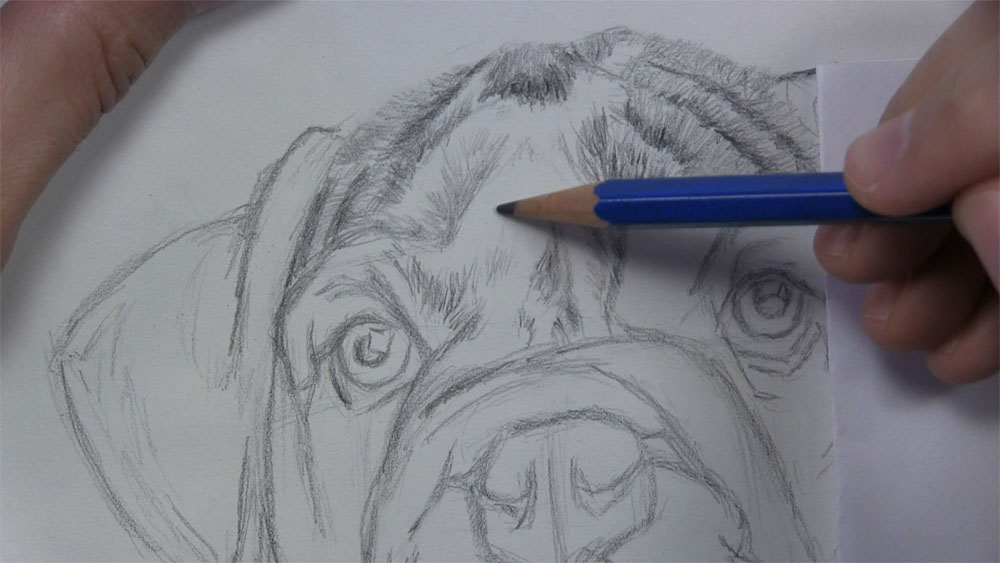
Shade the Dog’s Brows
Over the dog’s left eye, erase any stray guidelines. Then, darken the ridge between the white fur and the brown brow. On the brow itself, put a light layer of hair. Notice that the direction of the hairs is shifting to the right as we work our way to the right on this brow.

I’m switching to the 2B pencil for some shadow marks near the top of the brow. There is a deep groove in this dog’s brow, so put some darker tones in this area. The hairs are branching out from the inside, so let’s make our marks that way to show it.
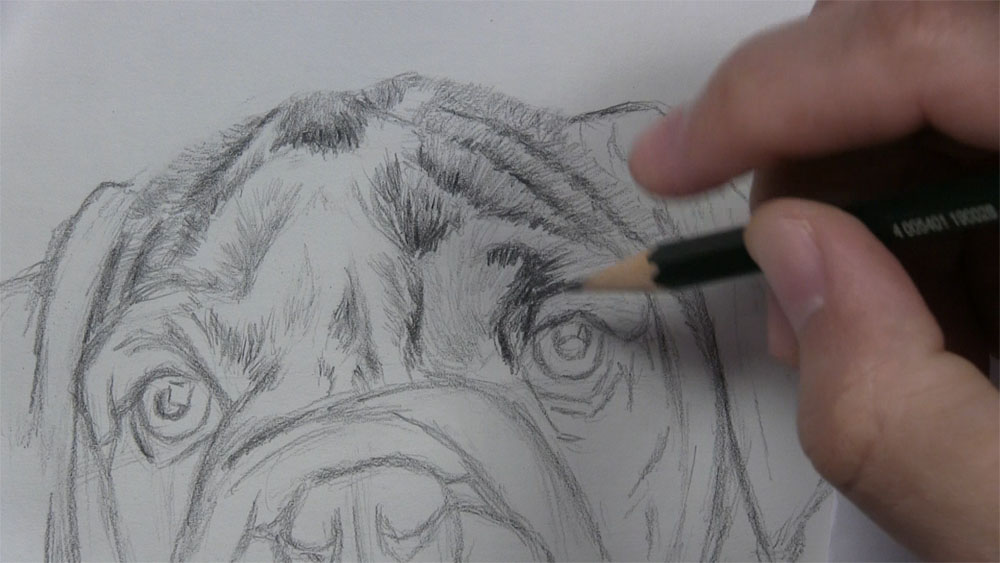
Start adding a second layer of fur atop this first layer. Stay consistent with the direction of hair growth as you draw the marks. Leave some areas untouched to show highlights in the fur. Go along the border between the white and brown fur and sketch more hairs on the brown side. Darkening the brown hairs will make the white hairs stand out that much more.
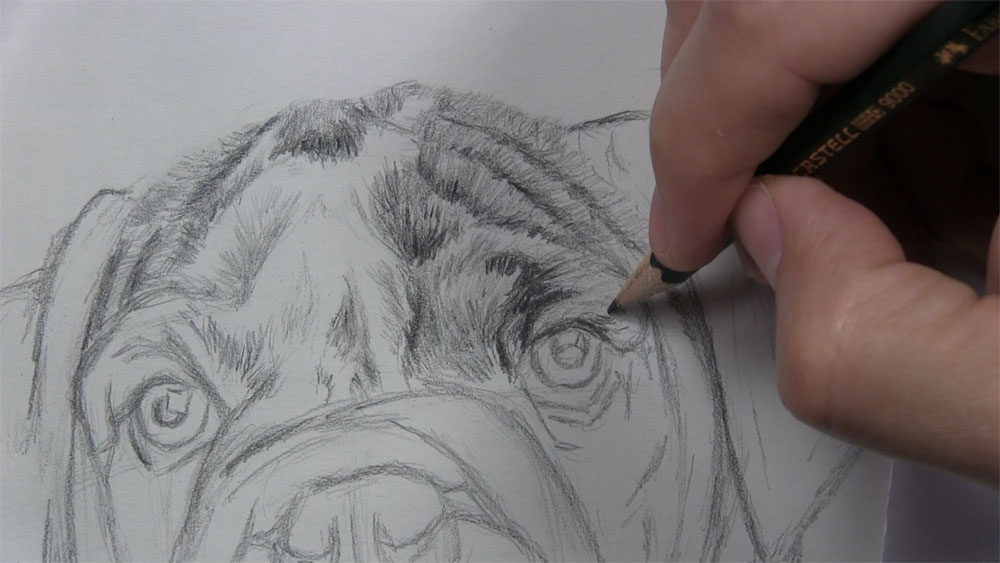
Shade the dog’s right brow in a similar way. Draw hairs radiating from the corner, up around the eye, and then pointing toward our left. Add darker tones to the inner corner of the eye. Use an HB pencil for a light base layer of fur before switching over to the 2B pencil for darker values.
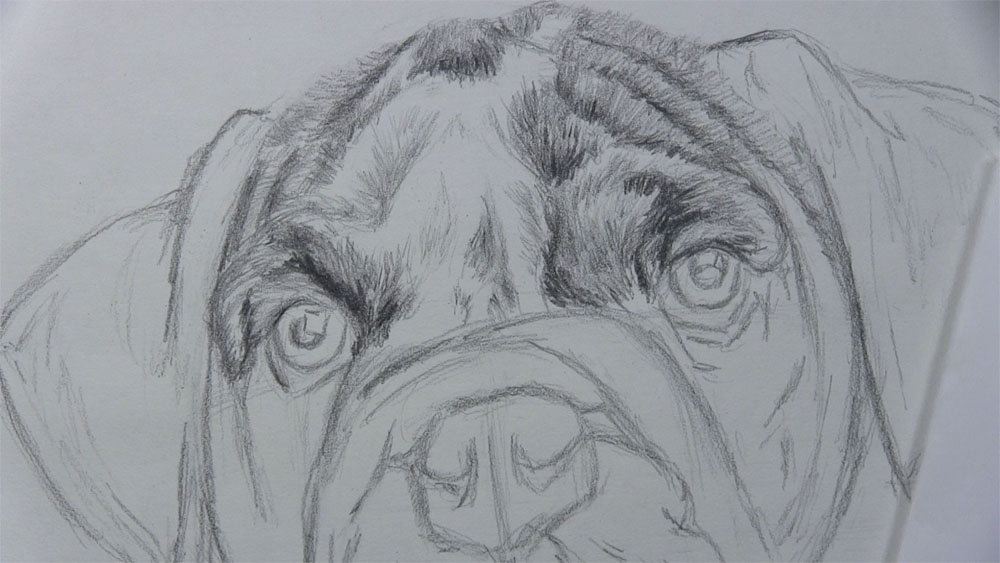
Shade the Dog’s Eyes
The eyes of dogs (and eyes in general) have a rich range of light and dark values. Therefore, it makes sense to use dark and light pencil tones when drawing them.
I’m going to start on the pupils, and I want them to be a very dark tone, so that’s why I am using a 6B pencil. Start by outlining the pupil, and then shade the inside. Be very careful to preserve the highlight. Repeat this process with the other pupil. After that, outline the iris of each eye.
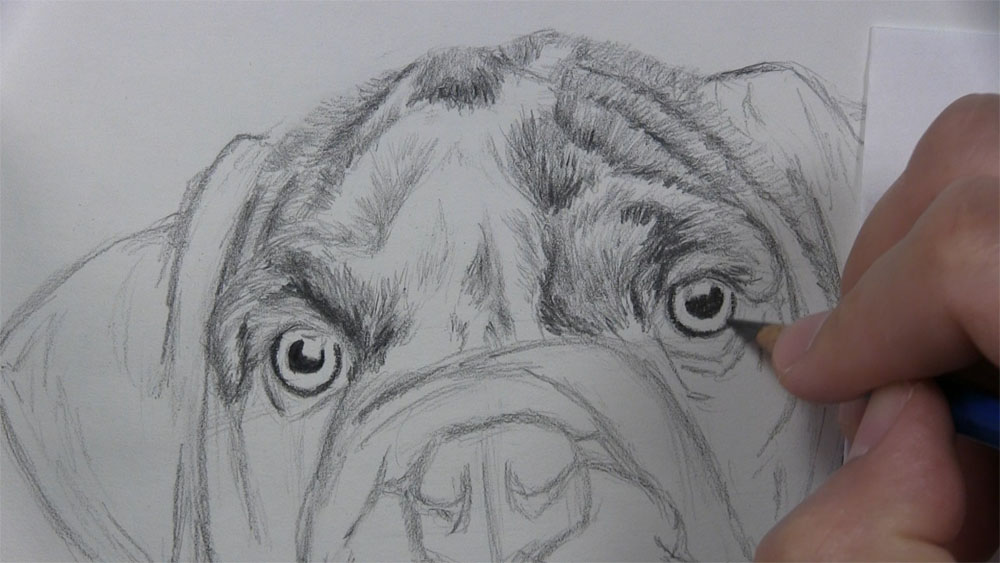
The irises are typically a lighter value as you get closer to the pupil. Therefore, I’m switching now to a 2B pencil. Sketch along the inside edge of the circle to make it appear thicker. As for shading, pretend there is an imaginary dot in the middle of the pupil. Then make lines very close together radiating from that imaginary dot outward to the edges of the iris. Do the same thing with the other eye.
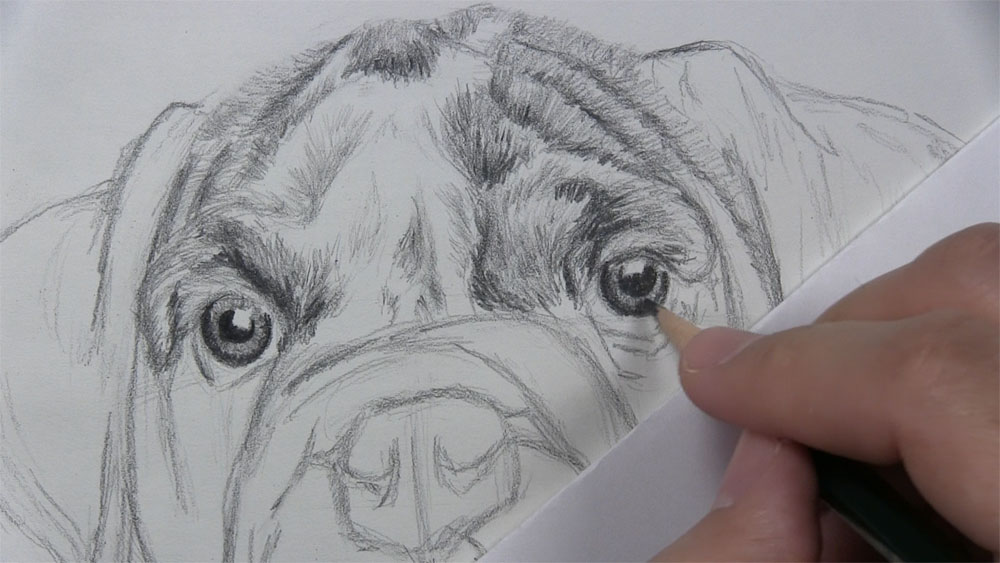
Okay, now it’s back to the 6B pencil. As we know, our dog has some very thick brows above the eyes. These thick brows stick out beyond the eyes, and therefore, cast a shadow underneath. Use the 6B to sketch a representation of this shadow and perhaps even some eyelashes. This also helps to better define the bottom of the brow.
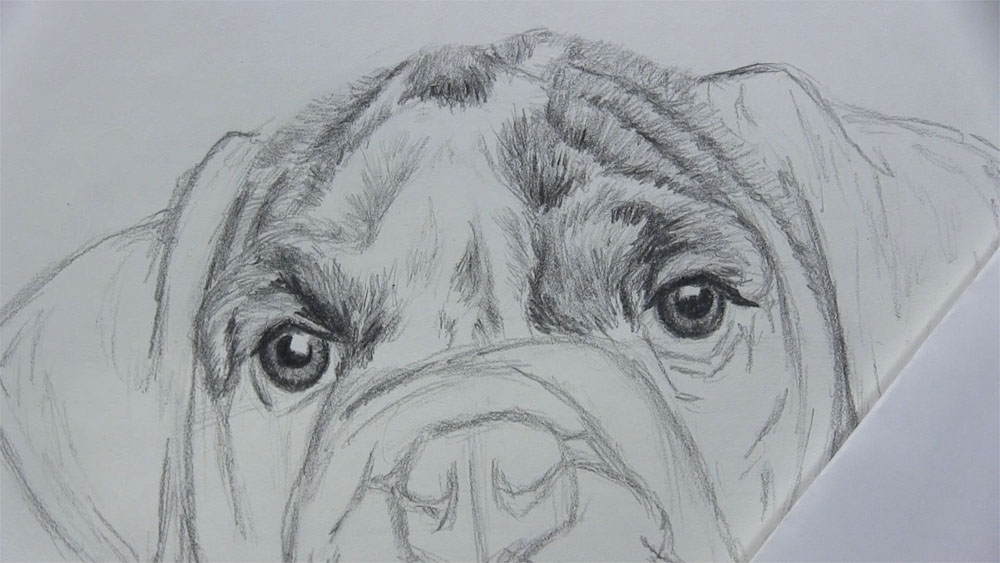
So, I have my HB pencil now to shade just the outer edge of the eyeball. We must remember that the eyeball is a sphere, and as light hits a sphere, the light gradually fades as you get closer to the edges of the sphere. We can outline the eyelid much darker though. Sketch some minute hairs at the corners of each eye.
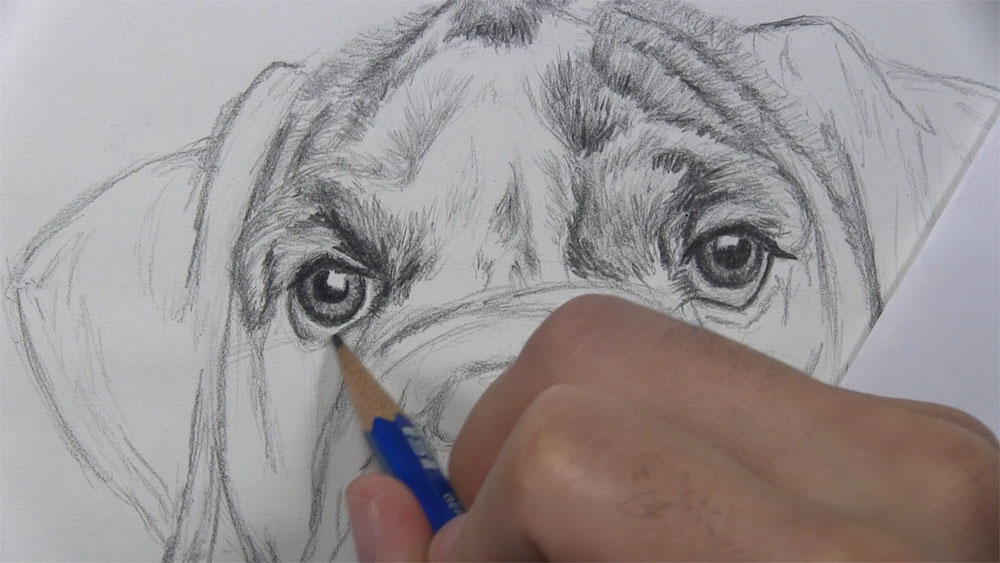
Draw Fur on the Sides of the Dog’s Face
Sketch fur on the sides of the face. Begin with a light base layer. Sketch most of the hair growing towards the outside edges of the face. Remember to erase the outline along the edge of the face before sketching the fur there. Sketch another darker layer of fur on top of the base layer. Some of this fur might curl upward or grow in different directions.
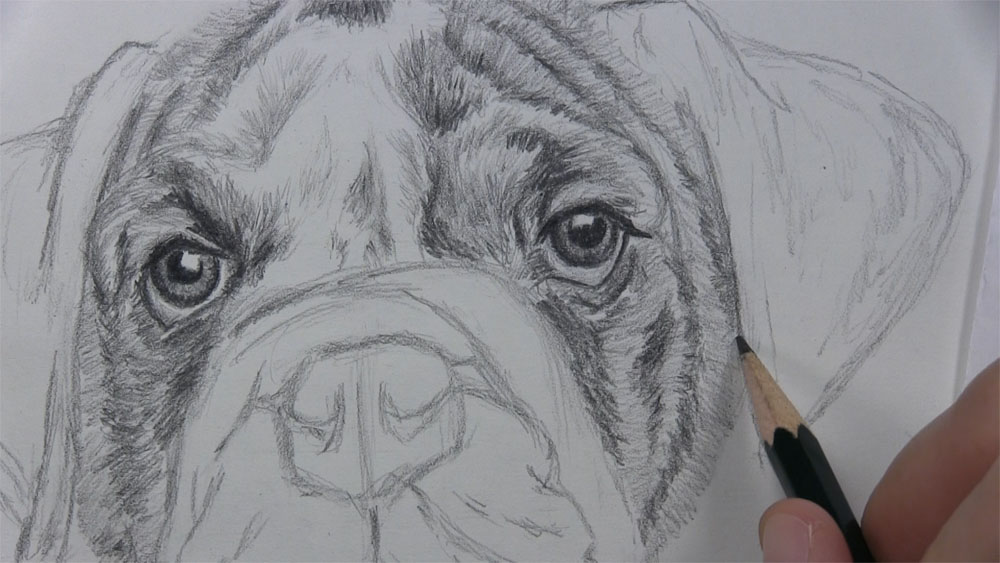
Keep adding darker tones around the eyes, from the lower eyelids to the outer corners of each eye. This extra shading around the eyes helps to add more form to the brows and surrounding features. Additionally, keep looking for other areas that need more tones applied to better distinguish between the white and brown fur. For the fold on the snout closest to the dog’s left eye, sketch some light downward hairs in the middle of the fold. Define the outer furry edge of the fold by placing some darker tones next to the white hairs.
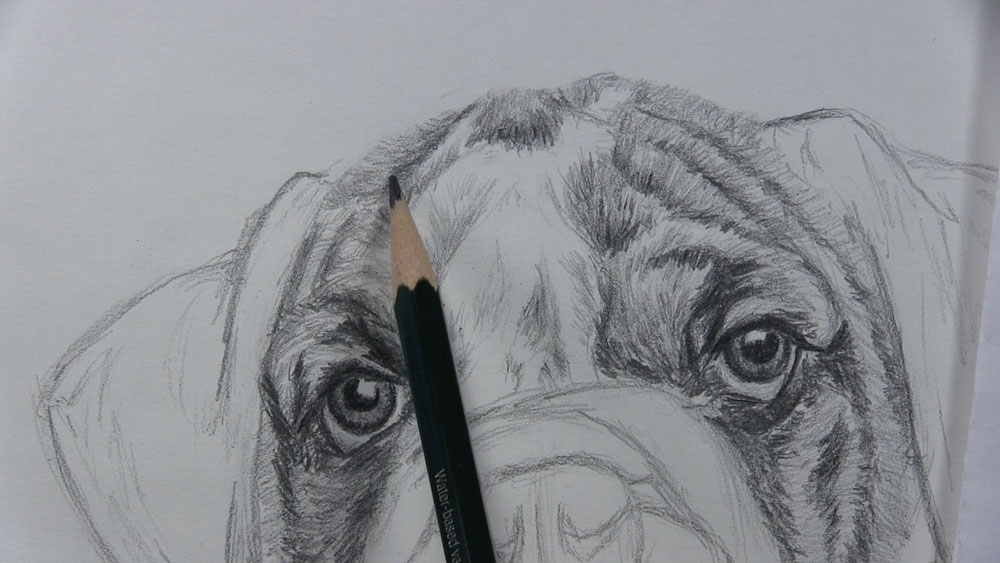
Shade the Dog’s Nose
We’re just about ready to shade the dog’s nose, but first let’s shade the area just above it. As I add the hairs on this fold, I’m putting a little twist to them along this edge just to help show the coil shape of the fold. Now, this dog has a spot on this fold just above his nose. Start by sketching the outline of the spot. Then shade darker tones inside.
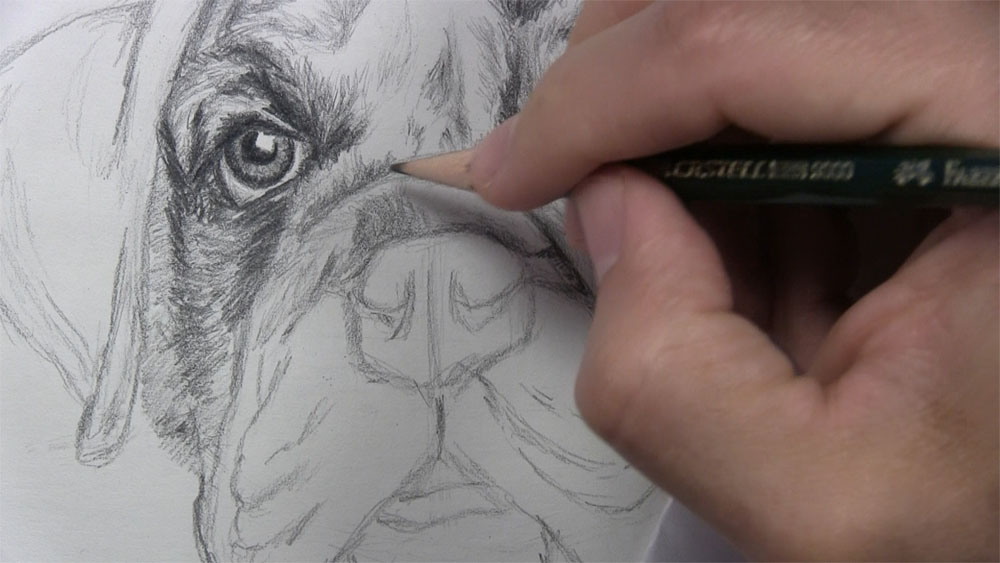
Okay, in the next several steps, I will show you how to draw a dog’s nose with shading that creates the nose’s bumpy texture. I’m putting a jagged texture along the top edge to represent the fur that’s sticking out from the fold and beyond the nose. Then, outline the contours of the nose.
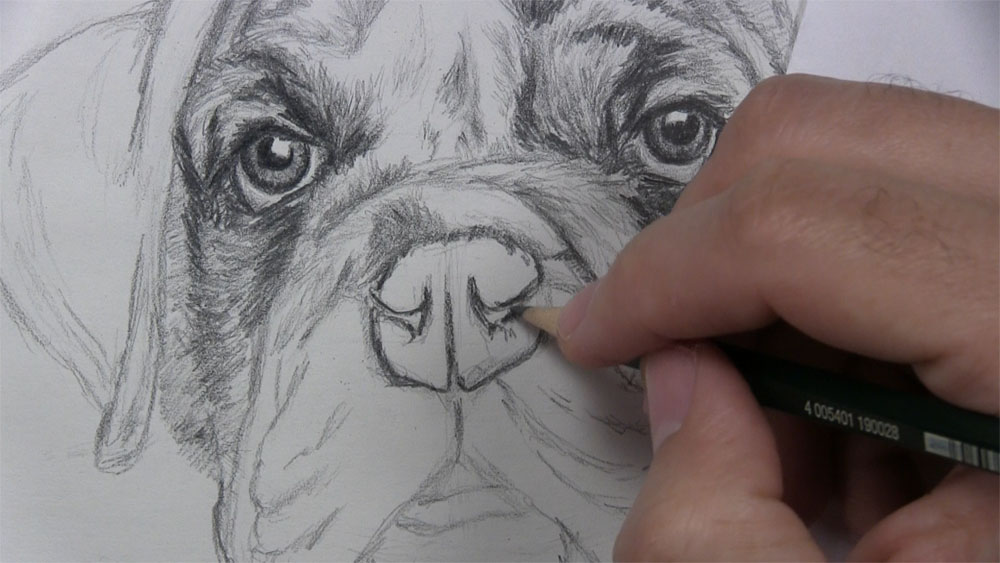
Start developing the texture of the nose by drawing some lines coming from the edges to the inner areas of the nose. You can imagine these as little grooves in the nose and even see them in the reference.
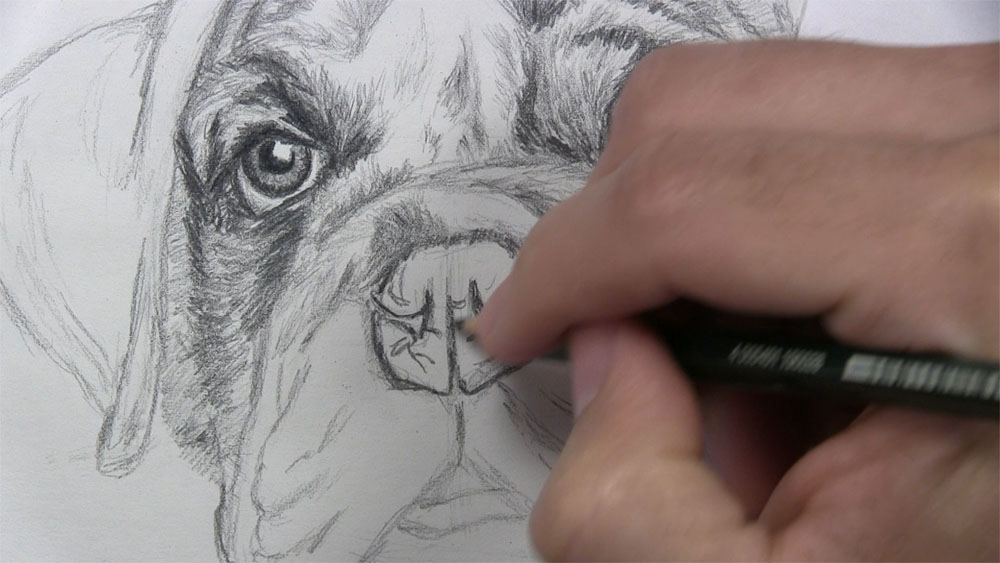
The dog’s nose has these circular bumps on the surface. We can begin to create a texture that resembles these bumps by drawing light, little circular scribbles on the surface. Scribble around the little grooves drawn in the last step.

Begin shading the nostrils and the various cracks along the outline of the nose. Since the nose has some very dark tones compared to the rest of the drawing, it’s a good idea to switch to the 6B pencil to go over the darkest areas.
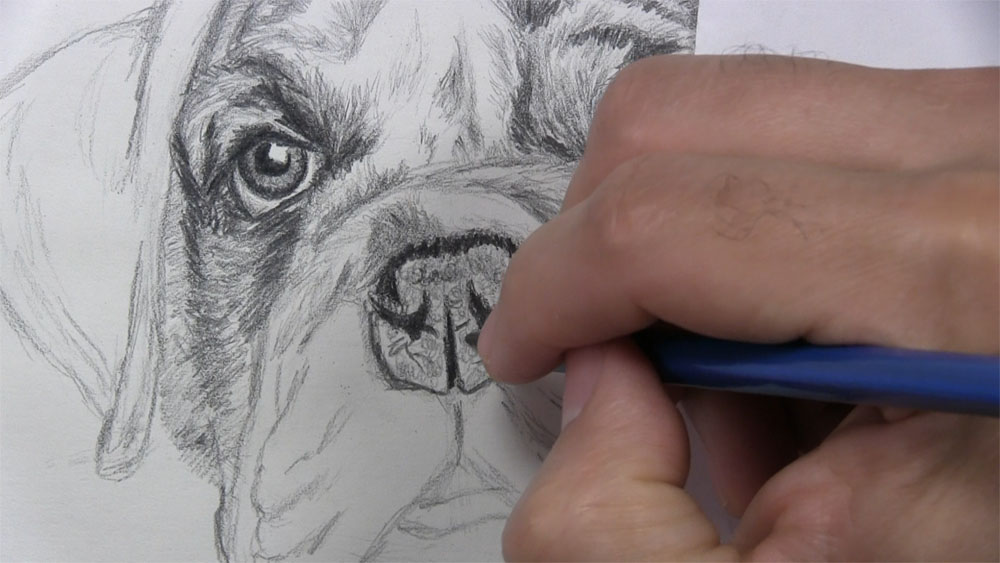
Keep using the 6B pencil to trace over the grooves and cracks on the nose’s surface. Then, build up the texture with a layer of dark circles and ovals. Rather than the scribbles from before, draw fewer individual round shapes, but still cover the surface.
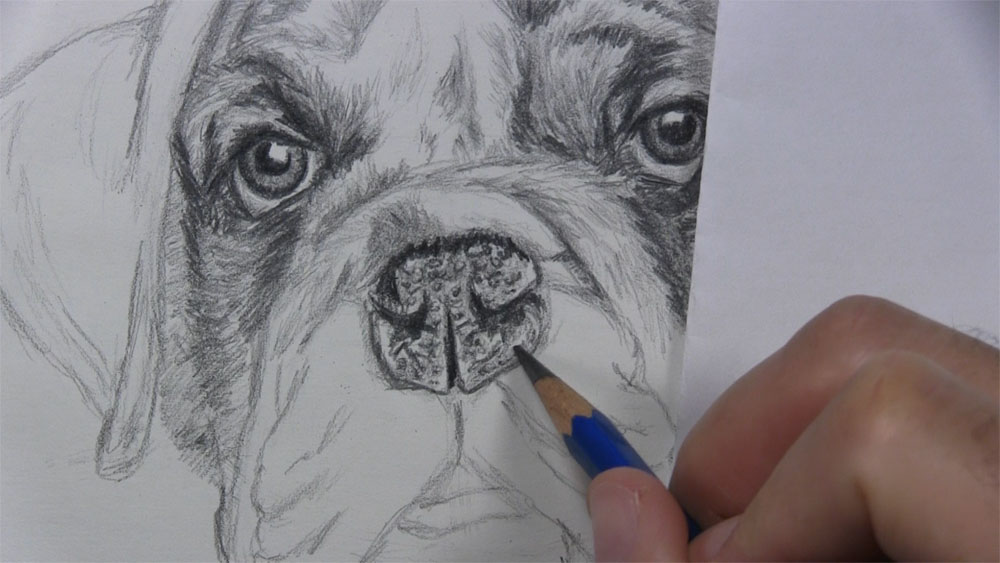
With a 2B pencil, shade the nose area one last time. Shade over and around the various round, bumpy shapes. Leave some of the edges of the nose and cracks a little lighter to resemble subtle highlights.
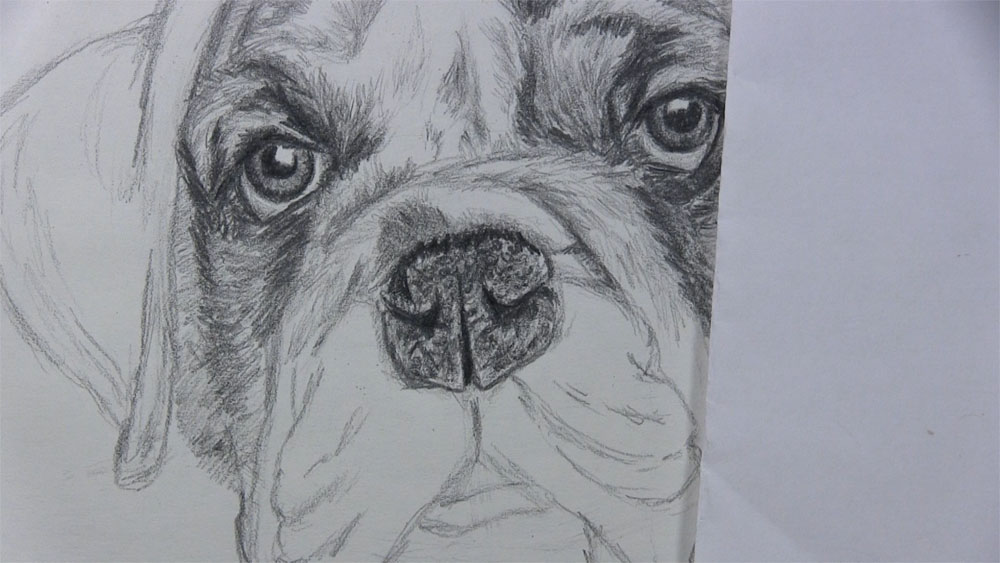
Shade the Dog’s Mouth and Snout
Trace over the vertical line extending from the nose to the mouth. Sketch fur over the outlines going down each side of the mouth. Trace over the outline for the top lip too. Then with a 6B pencil, shade the inside of the mouth very dark.
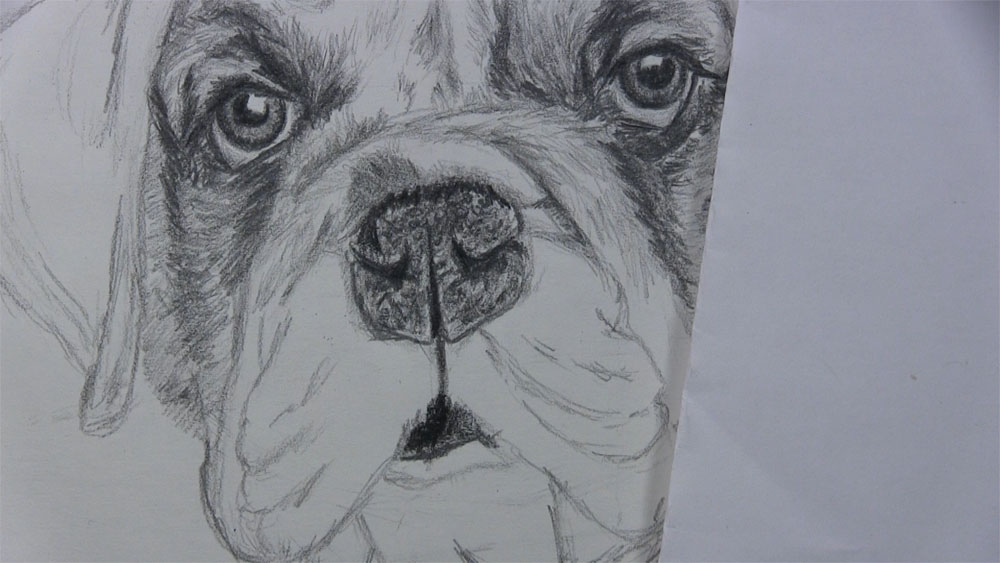
Similar to the spot above the nose, this dog has a large spot or birthmark covering the area between the nose and mouth. Sketch its outline as well as some texture details on each side of the vertical line joining the nose and mouth.

To shade this spot, I’m starting with a general base layer of diagonal strokes to cover the entire surface. Then, I’m going over it again with a second layer of shading. However, this time my strokes are shorter to more closely resemble hair. Finally, use darker tones to sharpen the edges just under the nose and around the mouth.
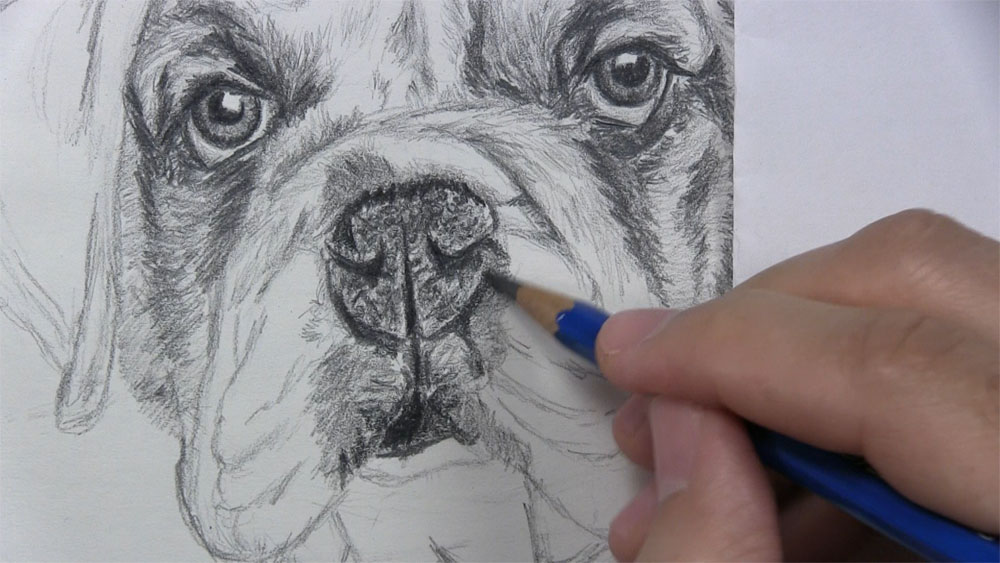
Use a light touch to sketch the white fur on the sides of the snout. The lower left area of the snout should have much darker fur. Sketch the fur under the dog’s mouth. Use a mix of shadows and lines coming downward from the mouth. You may notice that the right side of the snout does not have the dark patch of fur that was found on the other side.
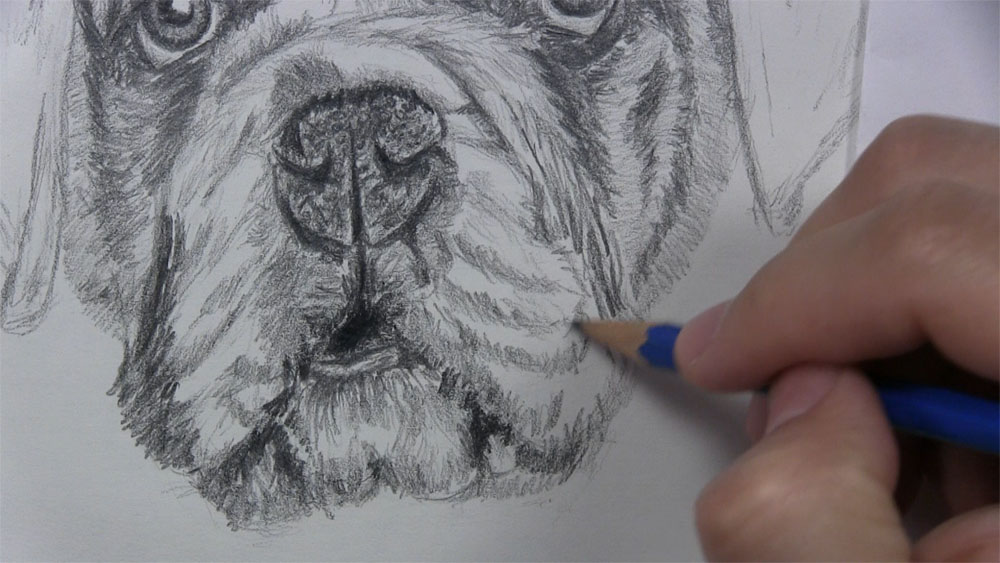
Shade the Ears and Finish Drawing the Dog Face
Now let’s work on the ears. Sketch a base layer of tones on the dog’s right ear, taking care to place darker values in the proper locations. Sketch another layer of tones to build up the texture of the fur. Replace the outline of the ear with short strokes to resemble the hair on the edge. Use a 6B for the darkest areas.
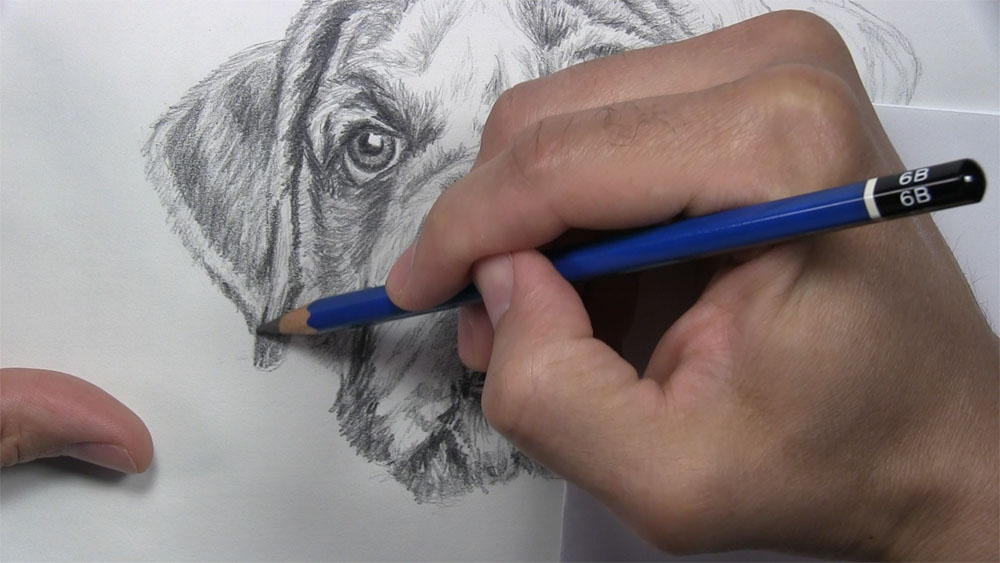
Repeat this process for the other ear. Sketch a base layer of shading for the ear. Use short pencil strokes along the edge of the ear to create that furry look. Build up the layers of fur on the ear with additional shadows.
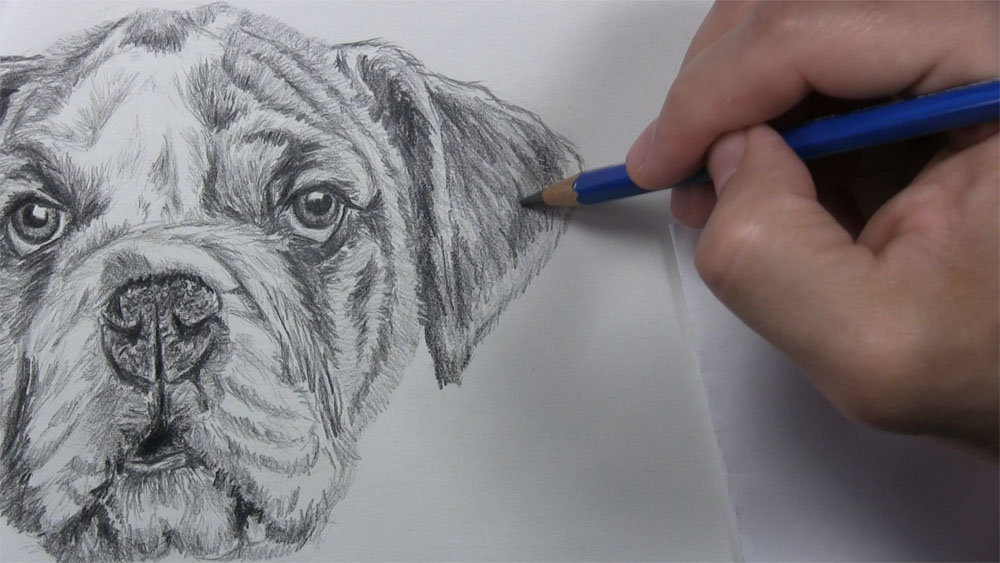
Okay, we are almost done. It’s time to add the finishing touches. Look for opportunities to make lighter values stand out better by creating darker values adjacent to them. Keep sketching over other parts of the face to build up volume while still preserving highlights. Don’t forget to add the whiskers!
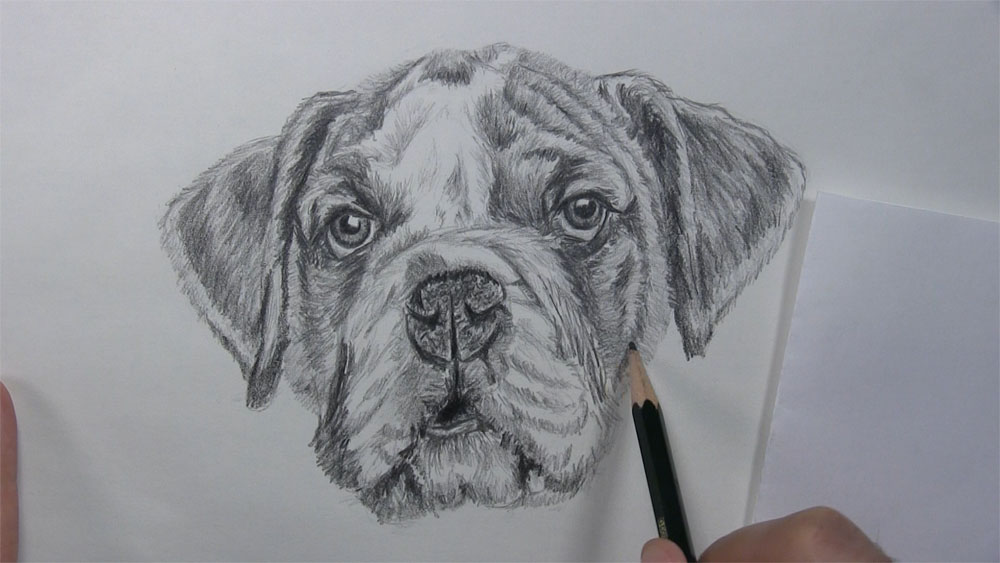
And that is how to draw a dog face with realistic features!
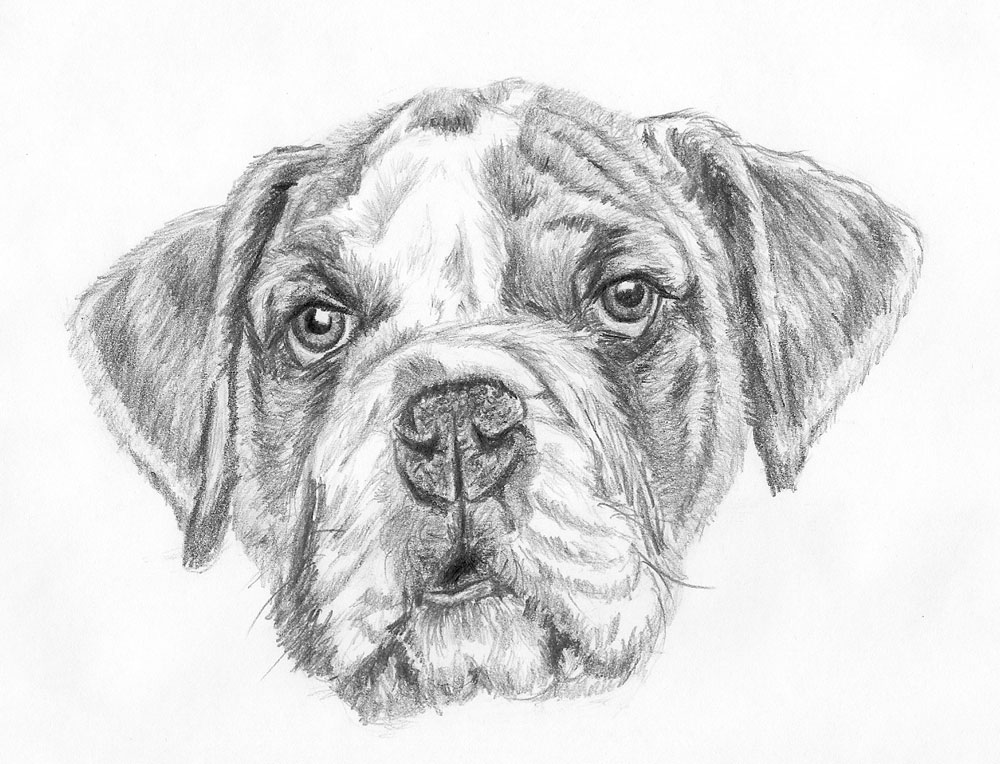
Tutorial Recap
For a quick visual recap of this tutorial, take a look at the image below. It shows you a progression of the main steps for how to draw a dog face, from the outline to the final result.
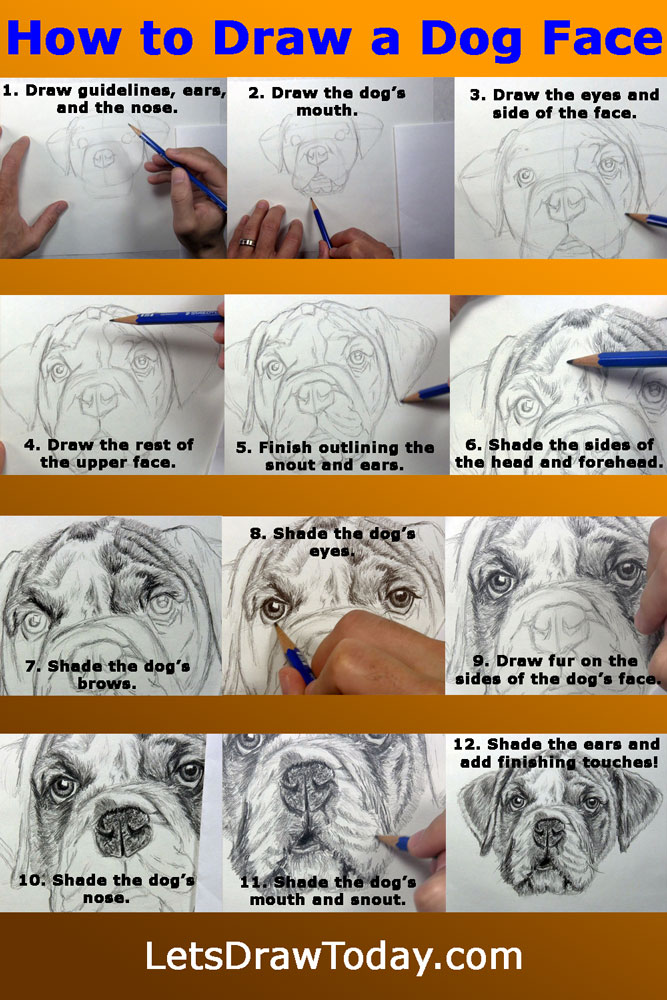
Tips to Remember the Next Time You Draw a Dog Face
Here are a few tips to keep in mind for the next time you want to draw the face of a dog.
- Work from a reference photo so you can stay true to the characteristics of the breed of dog you are trying to draw.
- Break your dog face into basic shapes that resemble the parts of the face. Then focus on one area and draw one feature or detail at a time.
- Consider using both a color and a black-and-white version of your reference. A black-and-white reference allows you to take some of the guesswork out of applying light and dark values. A color reference is useful when you are working on an area of the drawing that has two different colors adjacent to each other. A good example from this tutorial is the dog’s white and brown fur on the forehead. This allows you to take steps to ensure the color change is apparent in your shading.
- Try drawing a variety of dog faces of different breeds. The only way to truly get better at drawing dog faces is to practice as much as possible!
These tips work just as well for drawing other animals too!
I hope you have found this tutorial helpful, and I wish you the best of luck in all of your future attempts at drawing a dog face!


